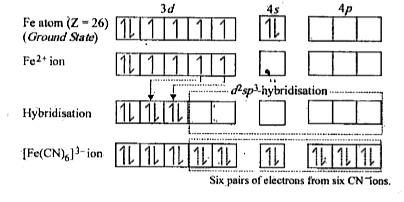On the basis of valence bond theory, explain the structure of [Fe(CN)6]3− complex.
Outer electronic configuration of iron (Z = 26) in ground state is 3d64s2. Iron in this complex is in the +3 oxidation state. Iron achieves the +3 oxidation state by the loss of two 4s electrons and one 3d electron. The resulting Fe3+ ion has outer electronic configuration of 3d6. It has been experimentally observed from magnetic moment values that this complex has one unpaired electron. To account for this, two unpaired elections in 3d-subshell pair up, thus leaving two 3d-orbitals empty. These two vacant 3d-orbitals, alongwith one 4s-orbital and three 4p-orbitals hybridise to give six equivalent d2sp3 -hybridised orbitals. Six pairs of electrons, one from each cyanide ion, occupy the six vacant hybrid orbitals so produced. The resulting complex has an octahedral geometry and is paramagnetic due to the presence of one unpaired electron. The hybridisation and the formation of the complex is illustrated below.

Topper's Solved these Questions
- CO-ORDINATION COMPOUNDSBOOK - BETTER CHOICE PUBLICATIONCHAPTER - CO-ORDINATION COMPOUNDSEXERCISE - QUESTION FROM PREVIOUS BOARD EXAMINATION
59 Videos
- CHEMISTRY IN EVERYDAY LIFEBOOK - BETTER CHOICE PUBLICATIONCHAPTER - CHEMISTRY IN EVERYDAY LIFEEXERCISE - QUESTIONS
76 Videos
- ELECTROCHEMISTRYBOOK - BETTER CHOICE PUBLICATIONCHAPTER - ELECTROCHEMISTRYEXERCISE - Numerical Problems
69 Videos
Similar Questions
Knowledge Check
Valence bond theory explains
Aconcept of resonance and molecular stabilityBessential covalent character of a chemical bondCtrivalency of boronDboth (a) and (b)
Discuss the nature of bonding in the following co-ordination complexes on the basis of valence bond theory :
(a) [Fe(CN)6]4− (b) [FeF6]3−
(c) [Co(C2O4)3]3− (d) [CoF6]3−
View SolutionWith the help of valence bond theory explain the bonding and shape of complex ion [Zn(NH3)4]2+ .
View SolutionDiscuss the nature of bonding in the following coordination entities on the basis of valence bond theory:
(i). [Fe(CN)6]4−
(ii). [FeF6]3−
(iii). [Co(C2O4)3]3−
(iv). [CoF6]3−
View SolutionDiscuss the nature of bonding in the following coordination entities on the basis of valence bond theory:
(i). [Fe(CN)6]4−
(ii). [FeF6]3−
(iii). [Co(C2O4)3]3−
(iv). [CoF6]3−
View SolutionDiscuss the nature of bonding in the following coordination entities on the basis of valence bond theory:
(i). [Fe(CN)6]4−
(ii). [FeF6]3−
(iii). [Co(C2O4)3]3−
(iv). [CoF6]3−
View SolutionExplain on the basis of valence bond theory that [Ni(CN)4]2− ion with square planar structure is diamagnetic and the [NiCl4]2− ion with tetrahedral geometry is paramagnetic.
View SolutionExplain on the basis of valence bond theory that [Ni(CN)4]2− ion iwth square planar structure is diamagnetic and [NiCl4]2− ion iwth tetrahedral geometry is paramagnetic.
View Solution
